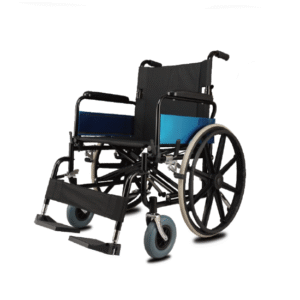Large Wheelchair: 5 Key Questions Answered—From Dimensions to Uses & Buying Guide
For users needing more space than a standard wheelchair provides, a large wheelchair is a vital solution. It balances extra room for comfort with the mobility needed for daily life, whether at home, work, or out in the community. But what makes a wheelchair “large,” and how does it differ from other models? Here are 5 critical questions answered to help you choose wisely.
1. What Defines a Large Wheelchair?
A large wheelchair is designed to offer more space than standard models while remaining more maneuverable than ultra-bulky bariatric options. Key specs include:
- Seat Width: 20–24 inches (wider than standard 16–18 inch seats) to accommodate broader hips, muscle mass, or mobility aids like leg braces.
- Overall Width: 30–36 inches (from wheel to wheel), fitting through most standard doorways (32+ inches) with room to spare.
- Weight: 40–60 lbs (heavier than standard wheelchairs due to sturdier frames but lighter than bariatric models, which can exceed 70 lbs).
- Weight Capacity: 300–400 lbs, supporting larger users without compromising stability.
2. How Does It Differ from Other Wheelchairs?
It fills a unique niche between standard and specialized models:
- Стандартные инвалидные коляски: Standard models (16–18 inch seats) feel cramped for larger users, risking pressure points or restricted movement. Large wheelchairs add 2–6 inches of seat width while keeping overall dimensions manageable.
- Bariatric Wheelchairs: Bariatric models (24+ inch seats, 400+ lbs capacity) prioritize extreme size but are bulkier (36+ inches wide), struggling in tight spaces. Large wheelchairs balance space and mobility for most users needing extra room.
- Легкие инвалидные коляски: Lightweight models (25–35 lbs) sacrifice width for portability. Large wheelchairs prioritize space over minimal weight, making them better for daily, long-term use.
3. Who Needs a Large Wheelchair?
It’s ideal for users who need more room than standard models offer but don’t require bariatric sizing:
- Adults with Larger Frames: Those with broad shoulders, wider hips, or taller statures (6’+ height) who find standard seats restrictive.
- Users with Mobility Aids: Individuals using leg braces, splints, or catheters need extra seat space to avoid discomfort or device damage.
- Long-Term Users: People spending 6+ hours daily in a wheelchair benefit from the added comfort of a properly sized seat, reducing muscle fatigue and pressure sores.
4. Key Features for Functionality & Comfort
- Frame Strength: Reinforced aluminum (lighter, 40–50 lbs) or steel (sturdier, 50–60 lbs) frames prevent bending under weight. Aluminum is better for users needing occasional transport; steel suits heavy daily use.
- Comfort Add-Ons: 2–3 inch thick padded seats (memory foam or gel) distribute weight evenly, while adjustable backrests (18–20 inches tall) support posture. Wide armrests (8–10 inches) reduce shoulder strain during self-propulsion.
- Maneuverability: Large rear wheels (20–24 inches) with ergonomic hand rims make self-propulsion easier, while 6–8 inch front casters pivot smoothly in tight spaces (e.g., kitchen corners).
- Safety Features: Anti-tip bars (standard on most models) prevent backward tipping, and extended brake levers (easy to reach) ensure secure stopping, even on slopes.
5. What to Consider When Buying
- Space at Home: Measure doorways, hallways, and furniture gaps. Ensure your space can accommodate 30–36 inch width—most homes with standard 32+ inch doors work, but older homes with 28–30 inch doors may require narrower large models (30–32 inches wide).
- Maneuverability Needs: If you navigate tight spaces (e.g., apartment hallways), opt for 30–32 inch overall width. For open homes or outdoor use, 32–36 inch models offer more comfort.
- Transport Options: Some large wheelchairs fold (bulkier than standard but manageable) for car transport. Check your vehicle’s trunk size—SUVs or vans work best, while compact cars may require a wheelchair lift.
- Budget: Prices range from $400 (basic steel frames) to $1,200 (premium aluminum with padded seats and adjustable parts). Insurance often covers part of the cost with a doctor’s prescription.
Conclusion
A large wheelchair is the sweet spot for users needing extra space without sacrificing mobility. By balancing width, durability, and maneuverability, it supports daily activities—from home use to public outings—with comfort and confidence.
Thank you for reading this, dear, if you have any suggestions about наш сайт or want to know about wheelchair, please связаться с нами. We will respond quickly.

